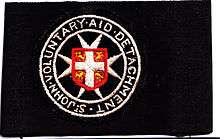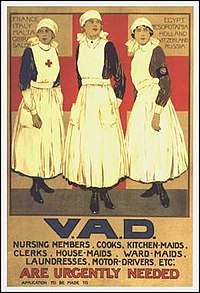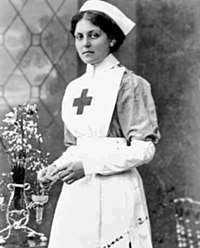Voluntary Aid Detachment
The Voluntary Aid Detachment (VAD) was a voluntary unit of civilians providing nursing care for military personnel in the United Kingdom and various other countries in the British Empire. The most important periods of operation for these units were during World War I and World War II. Although VADs were intimately bound up in the war effort, they were not strictly speaking military nurses, as they were not under the control of the military, unlike the Queen Alexandra's Royal Army Nursing Corps, the Princess Mary's Royal Air Force Nursing Service, and the Queen Alexandra's Royal Naval Nursing Service. The VAD nurses worked in field hospitals, i.e., close to the battlefield, and in longer-term places of recuperation back in Britain.

World War I

_-_at_Gledhow_Hall%2C_the_estate_of_her_cousin%2C_Baroness_Airedale.jpg)
The VAD system was founded in 1909 with the help of the British Red Cross and Order of St John. By the summer of 1914 there were over 2,500 Voluntary Aid Detachments in Britain. Of the 74,000 VAD members in 1914, two-thirds were women and girls.[1][2] In August 1914, just after the outbreak of war in Europe, the British Red Cross and the Order of St John proposed to form a Joint War Organisation with the intention of working with common aims, reducing duplication of effort and providing St John personnel with the protection of the Red Cross;[3] an agreement was concluded on 24 October 1914.[4]
At the outbreak of the First World War, VAD members eagerly offered their service to the war effort. The British Red Cross was reluctant to allow civilian women a role in overseas hospitals: most volunteers were of the middle and upper classes and unaccustomed to hardship and traditional hospital discipline. Military authorities would not accept VADs at the front line. Initially, the VADS were officially recorded as being assigned to the one hospital, but as time went on, they also worked - often unofficially and only for a few days at a time - at a number of hospitals in their local area, potentially providing a continuity of care to certain patients when hospital transfers occurred.[5]
Katharine Furse took two VADs to France in October 1914, restricting them to serve as canteen workers and cooks. Caught under fire in a sudden battle the VADs were pressed into emergency hospital service and acquitted themselves well. The growing shortage of trained nurses opened the door for VADs in overseas military hospitals. Furse was appointed commander-in-chief of the detachments and restrictions were removed. Female volunteers over the age of twenty-three and with more than three months' hospital experience were accepted for overseas service.
By 1916 the military hospitals at home were employing about 8,000 trained nurses with about 126,000 beds, and there were 4,000 nurses abroad with 93,000 beds. By 1918 there were about 80,000 VAD members: 12,000 nurses working in the military hospitals and 60,000 unpaid volunteers working in auxiliary hospitals of various kinds. Some of the volunteers had a snobbish attitude towards the paid nurses.[6]
VADs were an uneasy addition to military hospitals' rank and order. They lacked the advanced skill and discipline of trained professional nurses and were often critical of the nursing profession. Relations improved as the war stretched on: VAD members increased their skill and efficiency and trained nurses were more accepting of the VADs' contributions. During four years of war 38,000 VADs worked in hospitals and served as ambulance drivers and cooks. VADs served near the Western Front and in Mesopotamia and Gallipoli. VAD hospitals were also opened in most large towns in Britain.[2] Later, VADs were also sent to the Eastern Front. They provided an invaluable source of bedside aid in the war effort. Many were decorated for distinguished service.
At the end of the war, the leaders of the nursing profession agreed that untrained VADs should not be allowed onto the newly established register of nurses.[7]
Notable VAD nurses

Memoirists
Some VADs left written records of their service:
- Enid Bagnold, British author of the novel National Velvet, on which the 1944 film with Elizabeth Taylor was based. Her account of her experiences are related in her memoir A Diary Without Dates published in 1918.
- Vera Brittain, British author of the best-selling 1933 memoir Testament of Youth, recounting her experiences during World War I
- Agatha Christie, British author who briefly details her VAD experiences in her posthumously published Autobiography
- Frances Cluett, from Newfoundland, whose letters describe the horrors of World War I
- Lady Ursula d'Abo, English author who details her VAD experiences in her memoir titled The Girl with the Widow's Peak: The Memoirs
- E. M. Delafield, British author of the Diary of a Provincial Lady series and some 30 other novels; her experiences working at the Exeter VAD Hospital provided her with material for one of her most popular novels, The War Workers, published in 1918[8]
- Mollie Skinner (under the nom de plume R. E. Leake) wrote Letters of a V.A.D. (London: Andrew Melrose, 1918)
Medical personnel
People notable for their contributions to nursing, health, or science, or for their VAD service itself:
- Edith Cliff, commandant of Gledhow Hall Military Hospital, one of many such directors to be honoured for her nursing work
- Violet Jessop, British ocean liner stewardess trained as a VAD nurse after the outbreak of World War I. She had been a stewardess aboard the RMS Titanic when it sank in 1912 and was also aboard the hospital ship HMHS Britannic (the Titanic's sister ship) as a Red Cross nurse when it sank in 1916.
- Marjory Stephenson, biochemist, bacteriologist and one of the first two women elected to the Royal Society in 1945.
Other
Many VADs were prominent in other fields after the war:
- Ida Nancy Ashburn, Australian headmistress
- Mary Borden, Anglo-American novelist
- May Wedderburn Cannan, British poet
- Dame Rachel Crowdy, English nurse who was Chief of the Department of Opium Traffic and Social Issues Section of the League of Nations from 1919 to 1931.
- Lottie Dod, English sportswoman best known as a tennis player. She won the Wimbledon Ladies' Singles Championship five times in the late 19th century.
- Amelia Earhart, American aviation pioneer
- Hilda May Gordon, British painter
- Hattie Jacques, English comedy actress
- Naomi Mitchison, Scottish writer
- Olivia Robertson, British author and co-founder of the Fellowship of Isis
- Sophia Duleep Singh, suffragette
- Freya Stark, explorer and travel writer
- Jessie Traill, Australian painter[9]
- Anna Zinkeisen, Scottish painter and illustrator[10]
- Doris Zinkeisen, Scottish painter, commercial artist and theatrical designer[10]
- Janet Strathearn Smith, Scottish teacher; met her husband, Calvary Quarter Master Frank Davy; moved to Canada, raised 5 children, taught languages, wrote published articles.
Fictional VADs
Two Ernest Hemingway novels feature VADs:
- Brett/Lady Ashley in The Sun Also Rises and
- Catherine Barkley in A Farewell to Arms.
Agatha Christie's mystery novels feature several VADs, including:
- Cynthia Murdock in her first novel, The Mysterious Affair at Styles (1920),
- recurring character Prudence "Tuppence" Beresford and
- Nell Vereker in her 1930 novel Giant's Bread, written under the pseudonym of Mary Westmacott.
Examples by other authors:
- Mildred Haycock (nėe Blaides), who features in the novel sequence A Dance to the Music of Time by Anthony Powell.
- The novel Not So Quiet . . . by Helen Zenna Smith (a pseudonym for Evadne Price) recounts the experiences of VAD ambulance drivers who evacuated the casualties of World War I.
- The character of Georgina Worsley becomes a VAD in the fourth series of Upstairs, Downstairs, a fictional narrative based on the diaries of Lady Cynthia Asquith who was a VAD in the First World War.
- In the eighth chronological book of the Anne of Green Gables series, Rilla of Ingleside by L. M. Montgomery character Faith Meredith is a VAD. This is one of the few contemporary books to show the Canadian point-of-view during WWI.
- The character Celia Coplestone in T.S. Eliot's play The Cocktail Party (1949) becomes a VAD nurse after her failed affair with Edward Chamberlayne.
- The character of Lady Sybil Crawley becomes a VAD in the second series of Downton Abbey, the TV series that follows the lives of the aristocratic Crawley family and their servants.
- The novels A Girl Called Thursday and the sequel A Promise to Keep by Lilian Harry, also the character Val from the Burracombe Series of novels by the same author.
- The book My Story (Scholastic UK): War Nurse, the main character Kitty Langley becomes a VAD.
- Molly O'Sullivan (Ruth Bradley) is an Irish VAD nursing assistant in World War I who becomes a companion of the Eighth Doctor in the 2012 Big Finish boxset Dark Eyes.
- Sister Evangelina is described as a parachuting VAD in Jennifer Worth's Call the Midwife.
- Heather ("Hattie") Brown becomes a VAD in The Two Pound Tram by William Newton (Bloomsbury, 2003).
- Stella Bain is a VAD nurse in the novel Stella Bain by Anita Shreve.
- Mary Lamington who worked at a hospital in Isham in the Cotswolds and was later to become Richard Hannay's wife in John Buchan's Mr Standfast
- Sasha Fox, the protagonist of Marcus Sedgwick's 2005 teen fiction novel The Foreshadowing
- Katherine Trevelyan, Rosalie Berwick and Flora Marshall in the 2014 WWI Drama The Crimson Field
See also
Voluntary Service Detachment, a parallel organisation in Australia
References
- History of the VAD
- Voluntary Aid Detachments (VADs) at Spartacus.com Accessed May 2008
- "General overview of Joint War Committee activities during the First World War" (PDF). British Red Cross.
- Meyer, Jessica (2015). "Neutral Caregivers or Military Support? The British Red Cross, the Friends' Ambulance Unit, and the Problems of Voluntary Medical Aid in Wartime". War & Society. 34 (2): 105–120. doi:10.1179/0729247314Z.00000000050. PMC 4497454. PMID 26213442.
- Wynn, S. "Women in the Great War". Grub Street Publishers, 31 May 2017. Retrieved 14 June 2019.
Vera worked at five different hospitals. She started her VAD career as a nurse at the....
- Abel-Smith, Brian (1960). A History of the Nursing Profession. London: Heinemann. p. 86.
- "VADs & Nurses - Homefront Heroines". Qube. Retrieved 17 June 2019.
When the war ended, nursing profession leaders agreed that untrained VADs should not be allowed onto the newly established register of nurses.
- The Life of a Provincial Lady by Violet Powell, p. 32
- "Traill, Jessie Constance Alicia (1881–1967)". Australian Dictionary of Biography. National Centre of Biography, Australian National University.
- "Paintings by Doris Zinkeisen (1898–1991)". British Red Cross. Retrieved 17 April 2010.
Sources
- A VAD in France, Olive Dent, Diggory Press, ISBN 978-1-905363-09-4
Further reading
| Wikimedia Commons has media related to Voluntary Aid Detachments. |
- Digitised British Red Cross VAD Index Cards
- History of the VAD
- Memoirs of a World War II VAD
- Caring on the Home Front – Volunteer memories from World War II
- Relationship between VADs and professionally trained nurses in WW1
- A Diary Without Dates'
- The Vera Brittain Collection in The First World War Poetry Digital Archive by Oxford University contains images of Brittain's War poetry manuscripts, letters, diary, plus a searchable text corpora.
- an audio description of how one VAD nurse commuted to her VAD hospital, narrated by her grandson'